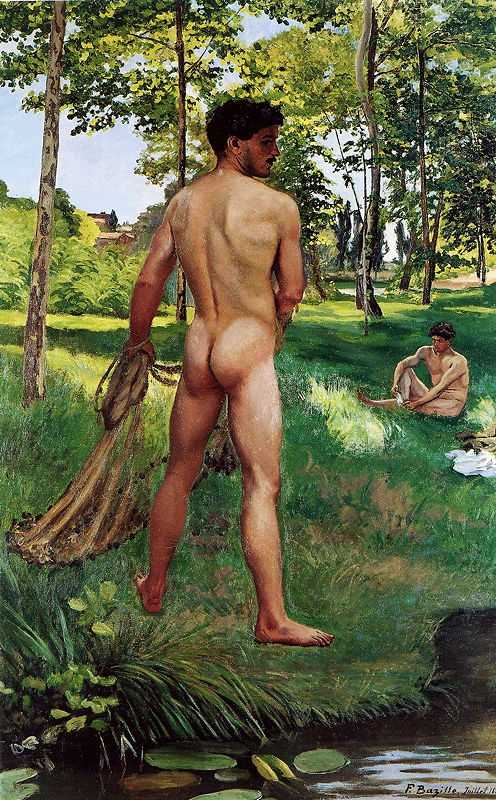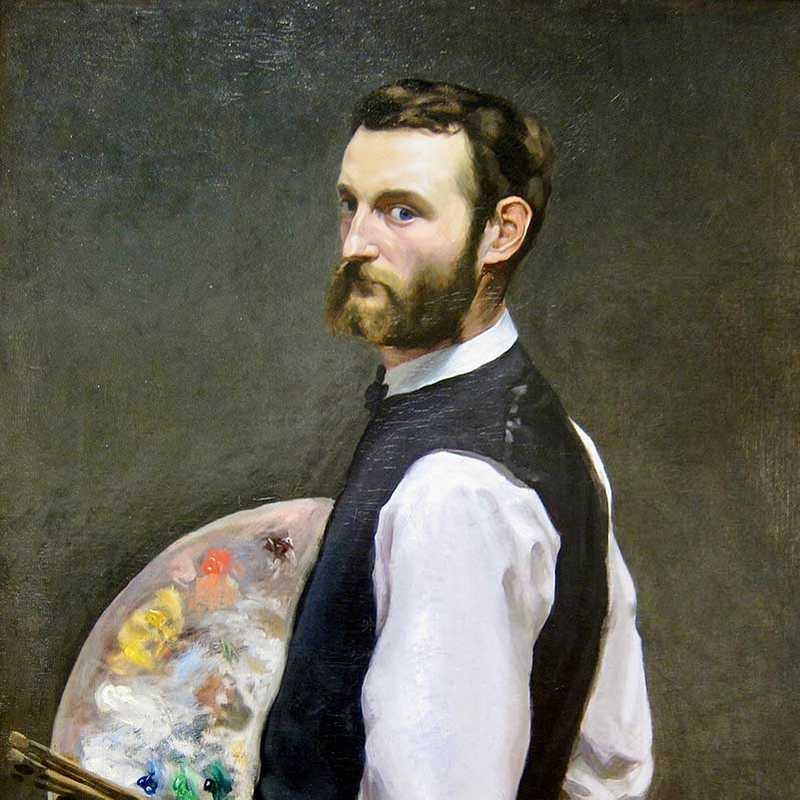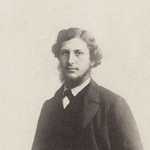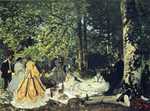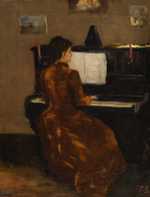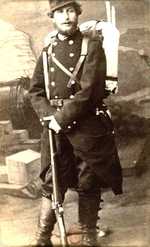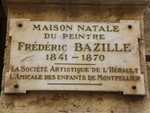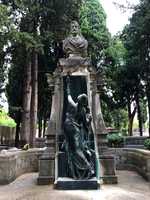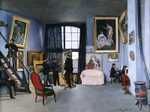1. Early Life
Frederic Bazille was born to a wealthy family who were artists by tradition.
This allowed him to lead a relatively carefree existence where he could pursue his interests without having financial worries.
6 December 1841: Frédéric Bazille, born Jean-Frédéric, is born into a wealthy family with deep roots in the South of France. He is born in his family's estate, Meric, outside of Montpellier. His family consists of artists who are expert goldsmiths and have earned fame and fortune from their skills.
Bazille's father, Gaston, is a well-known wine merchant and agronomist and his mother, Camille, is an exceptional pianist.
1859: At a young age, Bazille decides his passion lies in the arts and declares his decision to his parents. At the same time he joins Musée Fabre in Montpellier to take drawing and painting classes, while also engaging in learning sculpting from the father and son duo, Joseph and Auguste Baussan, the local sculptors. Bazille becomes skilled at draughtsmanship and works as a copyist, reproducing works by Old Masters.
Bazille's parents allow him to explore art on the condition that he would also pursue a more serious degree like medicine that will allow him to live comfortably.
2. The 1860s: Bazille's Mature Period
The 1860s was decade in which Bazille painted with fervour and made his mark as an artist.
Bazille is outgoing and has a busy social schedule, roaming the streets to enjoy the Parisian nightlife.
He is a regular at the cafes and bars that are popular among other artists such as Guerbois, Baudequin and Tortoni as well as impressionist group which included Claude Monet, Auguste Renoir, Camille Pissarro and Alfred Sisley.
Since he is wealthy compared to the other members of the group, it is common for him to pick up tabs for his friends and help them out when they need money, supplies or a place to stay.
Bazille also hangs out with a different crowd which includes the established artists Corot and Courbet. He is also friends with Henri Fantin-Latour, an academic painter and whose painting, A Studio in the Batignolles, features Bazille along with a group of anti-establishment painters of the time. He is also acquainted with Charles Baudelaire and Paul Verlaine who frequent the same establishments.
1862: Bazille moves to Paris and enrolls himself in the Faculty of Medicine as he had promised his parents. However, most of his free time is spent painting and associating with other artists instead of studying. He joins Charles Gleyre’s studio, an academic painter whose specialty is history painting. This is where he meets the future impressionists Monet, Renoir and Sisley.
1863: Bazille leaves the studio of Charles Gleyre as do the other impressionists because they do not agree with Gleyre's academic style. From 1863 onwards he paints regularly and goes on to establish his own first studio. Bazille’s studios (he had 6 in total throughout his lifetime) feature in some of his famous paintings and are called indirect self-portraits by some art historians. They include the studios on rue de Furstenberg, rue de Visconti, and one on rue de la Condamine.
Bazille’s artistic nature is not limited to painting; he is passionate about music to the extent that he seeks out a teacher to “give him lessons in harmony”. This passion of his is shared by his lifelong friend Edmond Maitre. In 1863 he buys a piano and gushes about it to his mother, begging her to send him music, including
“symphonies for four hands, Chopin waltzes, Beethoven sonatas and the Gluck score…”
The same year Monet starts the trend of painting outdoors in the Fontainebleau Forest and invites Bazille to join him. During the summer Monet takes Bazille to Normandy, his childhood home, and they spend time painting around Honfleur. In the meantime, Bazille is still enrolled in medicine but he gives it less and less attention.
1864: As might have been predicted, Bazille fails his medical exam, and his father gives in to his son’s interest and agrees to support him in his artistic career. His friends including Monet, Sisley, Gleyre and Manet show wholehearted support for his decision and Bazille returns the favor by helping his struggling friends financially. The same year he has Monet crashing at his studio at the rue de Furstenberg.
1865: Bazille features in Monet’s painting Luncheon on the Grass (1865-66) painted in response to Manet’s original work of the same name. Bazille is situated at the lower center of the canvas. Monet also shows his affection for Bazille by making the godfather of his son Jean.
1866: Bazille submits his paintings to the Salon and much to his chagrin, Girl at the Piano – for which he has high hopes - is rejected. Instead a smaller painting, Still Life With Fish is accepted. Bazille disappointment is so great that he paints over Girl at the Piano and the new painting is called Ruth and Boaz. The original painting is uncovered later using x-ray.
1867: Bazille sends a letter to his family which is evidence that the artist had ideas for joint exhibitions - which he couldn’t have known would come true after his death. The letter states that,
“A dozen young men think the same way as me,”
which was a reference to the impressionists he befriended at Gleyre’s studio, i.e., Renoir, Monet and Sisley. His idea is supported by others too including Morisot, Pissarro, Manet and Degas but this idea does not come to fruition because they couldn't raise enough money to buy or rent a studio for the exhibition.
1868: Bazille’s has a painting accepted by the salon for the second time. He presents The Family Reunion (Réunion de famille) which shows a group of his close family members seated together outdoors, painted during the summer spent at his family home near Montpellier. The painting is notable for its use of bright colors, especially the vibrant blue dresses and the greens of nature, and the contrasts created by tones of sunlight and shadow. Bazille is surprised: he wasn’t sure his submission was any good. When asked about the Salon’s decision to accept his work, he said:
"I don't know how, probably by mistake.”
1869: Bazille paints View of the Village which shows a young girl in a dress with a red sash in the foreground, with a sprawling village behind her, painted in bright gold and green. It is accepted by the Salon jury of 1869.
Other remarkable paintings from the last years of his life are the Summer Scene and Black Woman with Peonies. The summer scene portrays a group of young men having fun gathered round and dipping in the pool on a summer day; the background landscape is captivating due to the masterful demonstration of sunlight and shadow painted in vivid hues of blues and greens. It is a masterpiece that is the pinnacle of his style of realism and of combining figure drawing and landscape painting.
Black Woman with Peonies is an incredible painting which is reminiscent of Manet’s Olympia, the masterpiece that set impressionism on its course. Bazille takes the black servant holding flowers in Manet’s artwork and gives her the center-stage in his painting. The result is a beautiful, rich, and exotic painting that holds touches of Delacroix’s romanticism.
Interesting fact...
In the cold winter months Bazille would often retreat to his family’s estate of Meric situated in the outskirts of Montpellier in the South of France to find solace in the country. He would emerge from there with a number of beautiful paintings. As Edmond Duranty said of him, "Every spring Monsieur Bazille returns from the South with summer paintings ... full of greenery, sunshine and simple assurance" The Family Reunion is one example of his paintings from Montpellier.
1870: Bazille’s Studio, one of his most famous works, was completed. A few touches were added to this painting by Monet after Bazille’s death.
3. Enlistment and Early Death
By 1870, Bazille had earned renown and might have gone on to achieve more in his life when war struck.
Some of the impressionists stayed to fight while some fled: Renoir was conscripted to fight, Monet fled to London with his wife and young son, Cezanne went to L’Estaque in the South of France to avoid fighting, while Manet and Degas joined the national guard with Manet fighting in the front lines in Paris.
July 1870: On 19th July, France declares war on Prussia and France faces an imminent threat of a full-scale invasion of France.
August 1870: Bazille goes to a military recruitment office on 10th August to enlist in the army and joins the 3rd Zouaves light infantry regiment. Renoir jokes that he joined the Zouaves "to keep his beloved beard" since they "did not require shaving."
Bazille’s decision shocks his family and close friends. It is not clear what pushed Bazille to make this fateful decision, but some historians argue that he was not in a good place mentally and had stopped painting. Letters from friends pour in expressing shock and outrage - Renoir states in his letter,
“You are an imbecile to make this commitment because you have neither the right nor the duty! Merde! Merde! Merde!”
While Edmond Maitre wrote,
“My dear, my only friend. I received your letter in which you told me you have just signed up. You are crazy! Why didn't you consult your friends? May God protect you."
November 1870: On 28th November, in the battle of Beaune-la-Rolande which is waged by France to put a halt to the Siege of Paris, Bazille's unit is engaged in combat about 100 km south of the capital. After the commanding officer is injured, Bazille takes the lead, but is shot twice during an assault and dies on the battleground.
Bazille's grieving father travels to Beaune-la-Rolande a few days later to retrieve his son's body. Bazille, who was only 28 at his death, is buried in Montpellier.
4. Bazille’s Legacy
We will never know what else Bazille would have achieved had his life not been cut short by a pointless conflict.
1872: Louis Edmond Duranty publishes a fictional story, "The Painter Louis Martin," which has uncanny parallels with Bazille’s life, with some changes and additions. It chronicles the life of a passionate artist who dies young fighting in the war.
1900: Bazille’s paintings are exhibited in the Universal Exhibition in Paris before which his style and influence had lain almost forgotten.
1910: A retrospective exhibition of his work is organised in the Salon d'Automne which brings him to the attention of the radical contemporary artists such as Pablo Picasso, partly also due thanks to writer Guillaume Apollinaire’s recognition of the modernism in Bazille’s work, his similarity to Manet and the way they both reimagined nude paintings.


